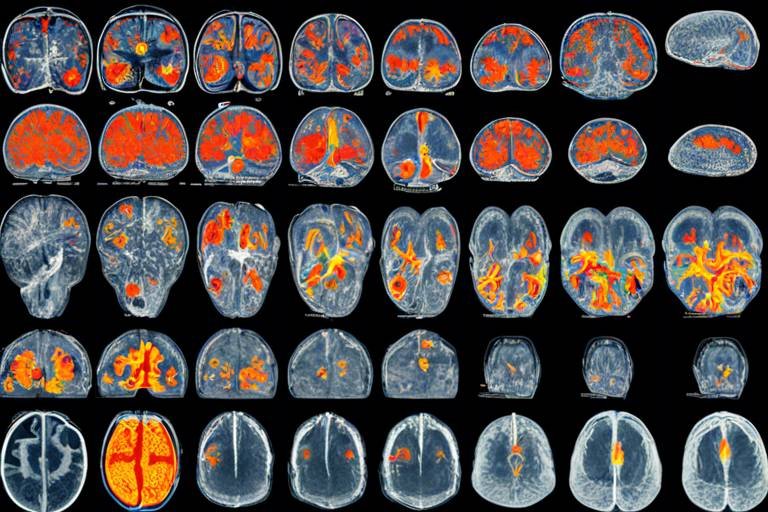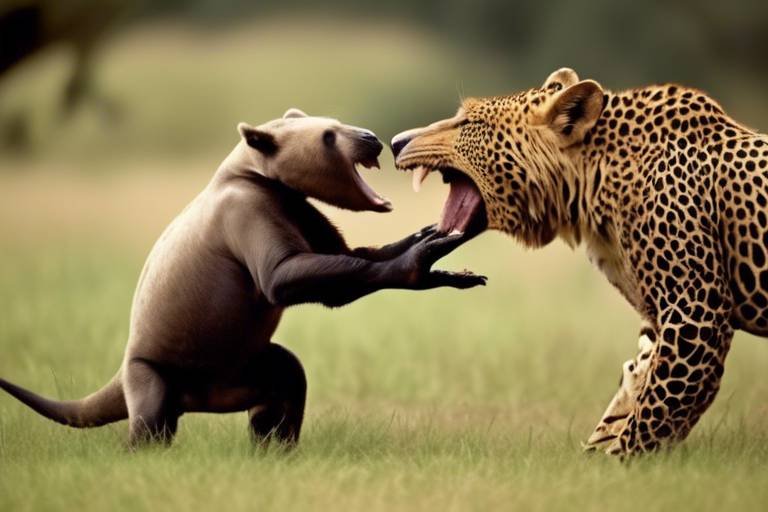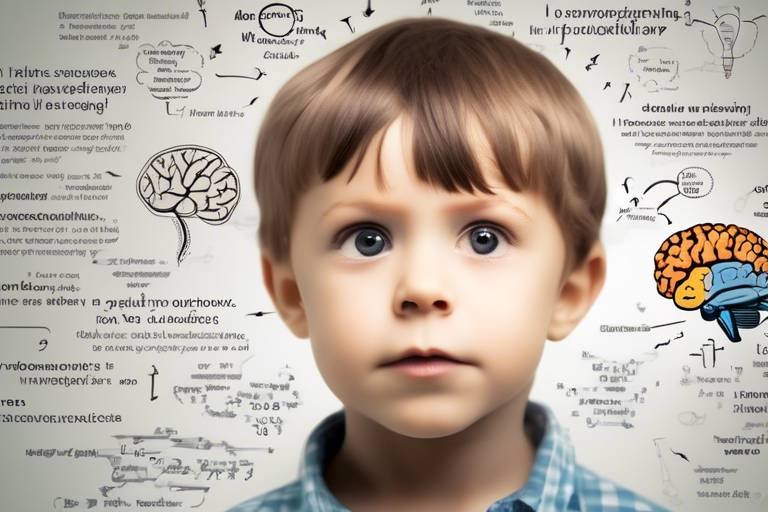How Advances in Scientific Communication are Shaping Public Understanding
In today's rapidly evolving world, the way we communicate science has undergone a significant transformation. With the advent of digital technology, traditional methods of disseminating scientific information are being replaced by more engaging and interactive approaches. This shift is not just a trend; it's a revolution that is reshaping how the public perceives and interacts with scientific knowledge. Imagine a time when scientific discoveries were confined to academic journals and conferences, accessible only to a select few. Now, thanks to advancements in communication, anyone with an internet connection can tap into a wealth of information about the latest research and innovations. This democratization of knowledge has profound implications for society, enhancing public understanding and engagement with science.
The importance of effective science communication cannot be overstated. It plays a crucial role in informing the public about pressing issues such as climate change, health crises, and technological advancements. When scientists share their findings in a clear and relatable manner, they not only foster a better understanding of complex topics but also encourage critical thinking and informed decision-making among the general populace. In a world where misinformation can spread like wildfire, the need for accurate and accessible scientific communication has never been more critical.
One of the most exciting aspects of this transformation is the role of social media. Platforms like Twitter, Facebook, and Instagram have become vital tools for scientists to connect directly with the public. No longer do researchers have to wait for their work to be published in journals; they can share their findings instantly, engaging with audiences in real-time. This direct line of communication fosters a sense of community and encourages dialogue between scientists and the public. It's like hosting a global conversation where everyone can contribute, ask questions, and share insights.
Moreover, the rise of visual communication in science has made complex concepts much more digestible. Infographics, videos, and interactive content have become staples in the toolkit of modern science communicators. For instance, consider how an infographic can break down intricate data into bite-sized pieces, making it easier for anyone to grasp key findings. This visual approach not only increases retention but also enhances the overall impact of scientific research on public discourse.
As we delve deeper into the nuances of scientific communication, we will explore various aspects such as the effectiveness of infographics, the power of video content, and the role of citizen science in fostering public engagement. Each of these elements plays a pivotal role in shaping how we understand and relate to science in our everyday lives.
- What is scientific communication?
Scientific communication refers to the ways in which scientific information is shared with the public, including through articles, social media, presentations, and educational materials.
- Why is effective science communication important?
Effective science communication helps the public understand complex scientific concepts, informs decision-making, and combats misinformation.
- How has social media changed science communication?
Social media allows scientists to engage directly with the public, share findings instantly, and foster community discussions around scientific topics.
- What role does visual content play in science communication?
Visual content, such as infographics and videos, simplifies complex data, making it more accessible and engaging for a broader audience.
- What is citizen science?
Citizen science involves public participation in scientific research, allowing individuals to contribute to data collection and analysis, thus enhancing public understanding of scientific processes.

The Role of Social Media in Science Communication
Social media platforms have truly revolutionized the way scientific information is shared and consumed. Imagine a world where scientists can communicate their groundbreaking discoveries directly to the public, bypassing traditional media gatekeepers. This is no longer a distant dream; it's the reality we live in today. Platforms like Twitter, Facebook, Instagram, and TikTok have become vital tools for researchers to engage with audiences in real-time, making science more accessible and relatable than ever before.
One of the most exciting aspects of social media is its ability to democratize information. No longer are scientific findings confined to academic journals or exclusive conferences. With just a few clicks, anyone can access the latest research, participate in discussions, and even ask questions directly to the scientists behind the work. This level of engagement fosters a sense of community and encourages more people to take an interest in scientific topics. Think about it: how many times have you come across a fascinating scientific fact while scrolling through your feed? That’s the power of social media!
Moreover, social media allows for the dissemination of information in more digestible formats. Scientists are now creating short videos, eye-catching infographics, and engaging posts that break down complex concepts into bite-sized pieces. This is particularly important in our fast-paced digital age, where attention spans are shorter than ever. A well-crafted tweet or an engaging Instagram story can spark curiosity and lead to deeper exploration of scientific topics.
However, the role of social media in science communication isn't without its challenges. The very same platforms that promote engagement can also facilitate the spread of misinformation. In a world where anyone can share their opinion, distinguishing credible scientific information from dubious claims becomes increasingly difficult. This is where scientists and communicators must step up their game. They need to not only share their findings but also actively engage in discussions, clarify misconceptions, and provide context for their research.
To effectively harness the power of social media, scientists can adopt several strategies:
- Be Authentic: Audiences appreciate genuine voices. Sharing personal experiences and challenges can make science feel more relatable.
- Utilize Visuals: Infographics and videos can significantly enhance understanding and retention of complex information.
- Encourage Interaction: Asking questions and prompting discussions can lead to a more engaged audience.
- Stay Informed: Keeping up with trends on social media can help scientists tailor their messaging to reach wider audiences.
In conclusion, the role of social media in science communication is transformative. It not only facilitates the sharing of knowledge but also fosters a community of informed individuals eager to learn and engage. As we continue to navigate this digital landscape, it’s crucial that scientists leverage these platforms responsibly, ensuring that accurate information prevails over misinformation. The future of science communication is bright, and social media is at the forefront of this exciting evolution.
- How can scientists effectively use social media? Scientists can use social media by sharing their research, engaging with the public, and utilizing visuals to make complex topics more accessible.
- What are the risks of misinformation on social media? Misinformation can spread rapidly on social media, leading to public confusion and distrust in scientific findings.
- Can social media enhance public engagement in science? Absolutely! Social media creates opportunities for direct interaction between scientists and the public, fostering a deeper understanding of scientific topics.

Visual Communication in Science
In today's fast-paced world, visual communication has become an essential tool for conveying complex scientific ideas. Traditional methods of communication, such as lengthy research papers and dense textbooks, can often alienate the general public. However, with the rise of digital media, scientists have the opportunity to present their findings in a way that is not only engaging but also easily digestible. Think of it this way: if a picture is worth a thousand words, then an infographic or a video can be worth a million. These visual tools break down barriers and make science more accessible to everyone.
Infographics have emerged as one of the most effective methods for simplifying data presentation. They can transform intricate datasets into visually appealing graphics that quickly convey key findings and trends. For example, consider a study on climate change. Instead of presenting pages of data, a well-designed infographic can illustrate temperature changes over the decades, highlight the impact of human activity, and even provide tips on how individuals can contribute to solutions—all in a format that is easy to understand. This visual approach not only enhances comprehension but also increases the likelihood that the information will be shared across social media platforms, reaching an even broader audience.
When creating infographics, it is crucial to apply effective design principles. Clarity is key; if your audience can't easily grasp the information presented, then the effort is wasted. Utilizing color theory can help emphasize important data points, while a well-thought-out layout can guide the viewer's eye through the information seamlessly. For instance, using contrasting colors to highlight significant statistics can draw attention and enhance retention.
| Design Principle | Description |
|---|---|
| Clarity | Ensure that the message is easily understood at a glance. |
| Color Theory | Use colors strategically to highlight important data and create visual interest. |
| Layout | Organize information in a logical flow to guide the reader's understanding. |
Moreover, examining successful case studies of infographics in scientific communication reveals best practices that can be adopted for future projects. For instance, the CDC's infographics on health issues have not only raised awareness but have also prompted action among the public. By analyzing these examples, scientists and communicators can glean insights into what resonates with audiences and how to effectively tailor their visual content for maximum impact.
In addition to infographics, video content has taken center stage in the realm of science communication. Documentaries and educational series serve as powerful platforms for scientists to share their research findings. These formats make complex topics more relatable and engaging for viewers. Imagine watching a documentary that takes you on a journey through the depths of the ocean, showcasing the impact of pollution on marine life. Such storytelling not only educates but also evokes an emotional response, fostering a deeper connection to the subject matter.
As we continue to embrace visual communication in science, it is essential to remember that the goal is not just to inform but to inspire. By breaking down complex ideas into visual formats, we can engage a wider audience, promote scientific literacy, and ultimately, encourage a more informed society.
- What is visual communication in science? Visual communication in science refers to the use of visual aids such as infographics, videos, and animations to present scientific information in an engaging and easily understandable way.
- Why are infographics important? Infographics are important because they simplify complex data, making it accessible to a broader audience, and they enhance the retention of information.
- How can I create effective infographics? To create effective infographics, focus on clarity, apply color theory, and maintain a logical layout to guide viewers through the information.
- What role does video play in science communication? Video plays a significant role in science communication by making complex topics relatable and engaging, often using storytelling to evoke emotional responses.

Infographics and Data Visualization
In the fast-paced world we live in, have emerged as powerful tools that bridge the gap between complex scientific data and public understanding. Imagine trying to explain a complicated scientific study filled with jargon and dense statistics to someone who isn’t familiar with the field. It can be like trying to navigate a maze blindfolded! Infographics, however, provide a clear pathway through this maze, transforming intricate information into visually appealing and easily digestible formats.
At their core, infographics are designed to present information quickly and clearly. They combine visuals—like charts, graphs, and images—with concise text to convey key messages. This approach not only enhances comprehension but also makes the information more memorable. Studies have shown that people retain information better when it is presented visually. In fact, our brains process visuals 60,000 times faster than text! So, when scientists use infographics, they’re tapping into a powerful method to communicate their findings effectively.
For instance, consider a recent study on climate change. Instead of presenting a lengthy report filled with technical data, scientists can create an infographic that highlights the most critical findings. This might include a striking graph showing rising temperatures, accompanied by images of melting glaciers, and concise bullet points summarizing the implications. Such a presentation not only grabs attention but also fosters a deeper understanding of the issue at hand.
However, creating effective infographics isn’t just about slapping some visuals together. It requires a careful application of design principles. Here are a few key elements that can significantly enhance the effectiveness of infographics:
- Clarity: The main message should be clear and easily understood at a glance.
- Color Theory: Colors should be chosen carefully to evoke emotions and highlight important data.
- Layout: A logical flow of information helps guide the viewer’s eye from one point to the next.
Moreover, examining successful infographics reveals best practices that can be adopted in future projects. For example, the World Health Organization often uses infographics to communicate health data during crises, such as the COVID-19 pandemic. Their infographics included clear visuals of infection rates and preventive measures, making it easier for the public to understand the gravity of the situation and the actions they needed to take.
In conclusion, infographics and data visualization are not just trendy tools; they are essential components of modern scientific communication. By distilling complex information into engaging visuals, scientists can effectively reach and educate the public, fostering a more informed society. As we continue to navigate the vast ocean of scientific knowledge, let’s embrace these innovative ways to make information accessible and impactful.
Q: What makes infographics effective in science communication?
A: Infographics are effective because they simplify complex data, making it visually appealing and easier to understand at a glance, which enhances retention and engagement.
Q: How can I create an effective infographic?
A: To create an effective infographic, focus on clarity, use appropriate colors, and ensure a logical layout that guides the viewer through the information.
Q: Are infographics suitable for all scientific topics?
A: While infographics can be used for many scientific topics, they are particularly effective for data-heavy subjects where visual representation can clarify trends and findings.

Effective Design Principles
When it comes to creating infographics for scientific communication, understanding is crucial. These principles not only enhance the visual appeal of the content but also significantly improve its clarity and impact. First and foremost, clarity is key; the audience should be able to grasp the main message at a glance. Avoid cluttering the infographic with excessive text or images. Instead, focus on a clean layout that guides the viewer's eye through the information seamlessly.
Another important aspect is color theory. The right color combinations can evoke emotions and highlight important data. For instance, using contrasting colors can help differentiate between various data sets, making it easier for viewers to compare and understand the information presented. However, it’s essential to use colors that are accessible to everyone, including those with color blindness. This means opting for color palettes that are not only visually appealing but also functional.
Furthermore, typography plays a significant role in effective design. The choice of fonts should enhance readability without distracting from the content. Using a maximum of two or three complementary fonts can create a cohesive look while still allowing for differentiation between headings and body text. Make sure that the font sizes are appropriate, ensuring that all text is legible even when viewed on smaller screens.
In addition, incorporating data visualization techniques such as charts and graphs can make complex information more digestible. For example, a well-designed bar chart can quickly communicate trends over time, while a pie chart can effectively illustrate proportions. The key here is to choose the right type of visualization that best represents the data being communicated.
Ultimately, the goal of applying these design principles is to create infographics that not only inform but also engage the audience. When the information is visually appealing and easy to understand, it is more likely to be shared and discussed, thereby increasing the reach and impact of scientific communication. As we continue to explore the intersection of design and science, these principles will serve as a foundation for creating effective and compelling infographics that resonate with a broad audience.
- What are the key elements of effective infographic design? Effective infographic design includes clarity, appropriate use of color, readable typography, and suitable data visualization techniques.
- How can I ensure my infographic is accessible? Use color combinations that are friendly for color-blind individuals, maintain high contrast, and ensure that all text is legible on different devices.
- What role does typography play in infographics? Typography enhances readability and helps guide the viewer through the information, making it essential for effective communication.

Case Studies of Successful Infographics
Infographics have emerged as a powerful medium for communicating complex scientific information in a visually appealing and easily digestible format. One standout case study is the “The Water Cycle” infographic created by the U.S. Geological Survey (USGS). This infographic not only illustrates the various stages of the water cycle but also highlights the importance of water conservation. By using vibrant colors and clear icons, it captures the attention of both children and adults, making it an effective educational tool.
Another notable example is the “Global Warming: The Facts” infographic produced by the BBC. This infographic breaks down the overwhelming data surrounding climate change into bite-sized pieces, showcasing key statistics and potential impacts in a way that is both alarming and informative. The combination of compelling visuals and succinct text allows the audience to grasp the urgency of the issue without feeling overwhelmed. It’s a perfect illustration of how effective design can enhance understanding.
Moreover, the “Human Genome Project” infographic serves as an excellent case study in the realm of genetic research. This infographic presents the complex information about the human genome in a structured manner, utilizing charts and diagrams to depict the mapping process and its implications for medicine and genetics. By simplifying a highly intricate subject, the infographic not only educates but also encourages discussions around genetics and its future applications.
To further illustrate the impact of these infographics, let’s look at a table summarizing some key features and outcomes of these successful case studies:
| Infographic Title | Creator | Key Features | Outcome |
|---|---|---|---|
| The Water Cycle | U.S. Geological Survey | Vibrant colors, clear icons, educational focus | Increased awareness of water conservation |
| Global Warming: The Facts | BBC | Key statistics, urgent tone, engaging visuals | Enhanced public understanding of climate change |
| Human Genome Project | Various researchers | Charts, diagrams, structured presentation | Stimulated discussions on genetics |
These case studies exemplify the effectiveness of infographics in scientific communication. By transforming complex data into engaging visuals, they not only enhance public understanding but also foster a greater interest in scientific topics. As we continue to explore the intersection of science and communication, it’s clear that well-designed infographics will play a crucial role in bridging the gap between scientists and the public.
What are infographics?
Infographics are visual representations of information, data, or knowledge designed to present complex information quickly and clearly. They often combine images, charts, and minimal text to convey a message effectively.
How do infographics enhance scientific communication?
Infographics enhance scientific communication by simplifying complex information, making it more accessible to a broader audience. They can help visualize data trends and relationships that might be difficult to understand through text alone.
Can infographics be used in other fields?
Absolutely! Infographics are widely used in various fields, including marketing, education, health, and technology, to communicate information effectively and engage audiences.
What makes a successful infographic?
A successful infographic is characterized by clarity, visual appeal, accurate data representation, and a well-structured flow of information. It should resonate with the target audience and effectively convey the intended message.

Video and Multimedia Content
In today's digital age, have emerged as some of the most powerful tools for communicating scientific ideas. Imagine trying to explain the intricacies of quantum mechanics through a lengthy article filled with jargon. Now, picture instead a captivating video that uses animations to illustrate these concepts in a way that even a child could understand. This shift from traditional text-based communication to dynamic multimedia formats has revolutionized how we engage with science.
One of the most significant advantages of video content is its ability to convey complex information in a digestible format. For instance, platforms like YouTube and Vimeo have become treasure troves of educational content where scientists and educators can share their research findings, explain theories, or even conduct live experiments. These videos not only make the information more relatable but also allow viewers to see real-world applications of scientific concepts, bridging the gap between theory and practice.
Moreover, the emotional impact of video cannot be overstated. A well-produced documentary can evoke feelings of wonder and curiosity, prompting viewers to delve deeper into scientific topics. Take, for example, the acclaimed documentary series Cosmos, which takes its audience on a journey through the universe, explaining complex astronomical phenomena while simultaneously inspiring awe. This kind of storytelling is crucial in capturing the public's imagination and fostering a lasting interest in science.
Additionally, the rise of interactive multimedia content—such as virtual reality (VR) and augmented reality (AR)—is opening up new frontiers in science communication. Imagine donning a VR headset and stepping into a 3D model of the human body, allowing you to explore its systems and functions firsthand. This immersive experience enhances learning and retention, making scientific concepts not just understandable but also memorable.
However, creating effective video content requires careful consideration of several factors. Here are some essential elements to keep in mind:
- Clarity: The message should be clear and concise, avoiding unnecessary jargon that could alienate viewers.
- Engagement: The content should be engaging, using storytelling techniques to draw viewers in and keep them interested.
- Visual Appeal: High-quality visuals and animations can significantly enhance the viewer's experience, making complex ideas easier to grasp.
To sum it up, video and multimedia content are not just supplementary tools in scientific communication; they are becoming essential. They offer a unique way to connect with audiences, making science more accessible and enjoyable. As technology continues to evolve, we can expect even more innovative approaches that will further enhance our understanding and appreciation of the scientific world.
- What types of video content are most effective for science communication? Engaging documentaries, educational series, and interactive videos tend to resonate well with audiences.
- How can I create impactful science videos? Focus on clarity, storytelling, and high-quality visuals while ensuring the content is relatable and engaging.
- Are there any platforms specifically for science communication videos? Yes, platforms like YouTube, Vimeo, and even social media channels like Instagram and TikTok are popular for sharing science-related content.

The Impact of Citizen Science
Citizen science is more than just a buzzword; it represents a significant shift in how scientific research is conducted and perceived. By inviting the public to participate in scientific endeavors, we are not only democratizing science but also fostering a deeper understanding of scientific processes among everyday people. Imagine a world where anyone, regardless of their educational background, can contribute to groundbreaking research! This is the essence of citizen science, where individuals become active participants rather than passive consumers of information.
One of the most exciting aspects of citizen science is its ability to empower communities. When people engage in data collection and analysis, they develop a sense of ownership and pride in their contributions. This engagement fosters a greater appreciation for scientific inquiry and cultivates a more scientifically literate society. For instance, projects like the Audubon Society's Christmas Bird Count have not only provided valuable data on bird populations but have also connected thousands of individuals with nature and conservation efforts. These experiences can be transformative, igniting a passion for science in individuals who may never have considered themselves scientists.
Moreover, citizen science initiatives often address pressing societal challenges. By harnessing the collective efforts of volunteers, researchers can gather vast amounts of data that would be difficult or impossible to collect otherwise. For example, environmental monitoring projects that involve community members in tracking local pollution levels or biodiversity can lead to significant insights that inform policy decisions and conservation strategies. This collaborative approach not only enhances research outcomes but also encourages community involvement in scientific inquiry, making science more relevant to the lives of individuals.
However, it's essential to recognize that citizen science is not without its challenges. While it offers numerous benefits, the quality of data collected can vary significantly based on the participants' expertise and training. Ensuring that volunteers are adequately prepared and informed is crucial for maintaining the integrity of the research. This is where effective training and support systems come into play. Researchers must develop clear guidelines and provide resources to help citizen scientists understand their roles and responsibilities.
In conclusion, the impact of citizen science is profound and multifaceted. It not only enhances scientific research but also fosters a more engaged and informed public. By breaking down traditional barriers between scientists and the community, we create a collaborative environment that benefits everyone involved. As we continue to embrace citizen science, we must also address its challenges to maximize its potential and ensure that it serves as a powerful tool for understanding and addressing the complex issues facing our society today.
- What is citizen science? Citizen science involves public participation in scientific research, allowing non-professionals to contribute to data collection and analysis.
- How can I get involved in citizen science projects? You can participate by joining local initiatives, online platforms, or community science projects that align with your interests.
- What are some examples of successful citizen science projects? Examples include the Christmas Bird Count, Galaxy Zoo, and iNaturalist, which engage the public in various scientific fields.
- What challenges does citizen science face? Challenges include ensuring data quality, varying participant expertise, and the need for effective training and support.

Benefits of Citizen Science
Citizen science is not just a buzzword; it's a dynamic movement that is reshaping the landscape of scientific research. By inviting the public to participate in scientific endeavors, we are witnessing a remarkable shift in how knowledge is created and shared. One of the most significant benefits of citizen science is its ability to enhance public engagement with scientific topics. When ordinary people contribute to real research, they gain a deeper understanding of scientific processes and methodologies. This hands-on experience demystifies science, transforming it from an abstract concept into a tangible reality.
Moreover, citizen science fosters a sense of community and collaboration. When individuals from diverse backgrounds come together to tackle scientific questions, they not only contribute their unique perspectives but also build strong social networks. This collective effort can lead to innovative solutions to pressing societal challenges, such as climate change, biodiversity loss, and public health crises. For instance, local communities often have invaluable knowledge about their environments, which can enhance data collection efforts and lead to more relevant findings.
Another key advantage of citizen science is its potential to democratize data collection and analysis. Traditionally, scientific research has been the domain of trained professionals, but citizen science breaks down these barriers. It allows anyone with an interest to contribute, regardless of their educational background. This inclusivity not only enriches the data pool but also promotes scientific literacy among participants. As they engage with scientific concepts, participants become more informed citizens, better equipped to engage in discussions about science-related policies and practices.
To illustrate the impact of citizen science, consider the following benefits:
- Enhanced Research Quality: Citizen scientists can collect vast amounts of data, which can lead to more comprehensive and robust research outcomes.
- Increased Public Awareness: Engaging the public helps raise awareness about scientific issues, leading to a more informed society.
- Empowerment: Participants feel empowered as they contribute to meaningful scientific inquiries, boosting their confidence and interest in science.
Furthermore, citizen science initiatives often result in significant cost savings for research projects. By leveraging volunteer efforts, scientists can allocate funding to other critical areas, such as data analysis or dissemination of findings. This efficiency not only maximizes resources but also accelerates the pace of scientific discovery.
In conclusion, the benefits of citizen science extend far beyond the immediate research outcomes. They contribute to building a scientifically literate society, foster community engagement, and promote a culture of collaboration and curiosity. As we continue to embrace this participatory approach to science, we pave the way for a brighter, more informed future.
Q: What is citizen science?
A: Citizen science refers to the involvement of non-professionals in scientific research, allowing them to contribute to data collection and analysis.
Q: How can I get involved in citizen science projects?
A: There are numerous platforms and organizations that offer citizen science opportunities. Websites like citizenscience.org provide listings of ongoing projects you can join.
Q: What are some examples of successful citizen science projects?
A: Successful projects include the Audubon Society's Christmas Bird Count, which tracks bird populations, and Zooniverse, where volunteers help classify galaxies and other scientific data.
Q: Do I need a science background to participate in citizen science?
A: No, citizen science is designed to be accessible to everyone, regardless of their background. Many projects provide training and resources to help you get started.

Challenges and Limitations
While the evolution of scientific communication has opened up new avenues for engagement and understanding, it is not without its . One of the most pressing issues is the question of data quality assurance. When the public is invited to participate in scientific research, there is a risk that the data collected may not meet the rigorous standards required for valid scientific conclusions. This is particularly concerning in fields where precision is paramount, such as environmental monitoring or medical research. Ensuring that citizen scientists are adequately trained and supported is essential, yet this can be resource-intensive and complex.
Another challenge lies in the varying levels of participant expertise. Citizen science projects often attract a diverse group of individuals, from seasoned professionals to enthusiastic amateurs. This disparity can lead to inconsistencies in data collection and interpretation. For instance, a project that relies on public observations of wildlife may receive reports that are influenced by the observer's prior knowledge or biases. Therefore, it becomes crucial to establish clear guidelines and provide adequate training to ensure that all participants are on the same page.
Moreover, the impact of misinformation cannot be overstated. In an age where information spreads like wildfire, distinguishing between credible scientific data and misleading claims is a daunting task. Citizen scientists may inadvertently contribute to the spread of misinformation if they lack the tools to critically evaluate the information they encounter. This situation calls for robust educational initiatives that empower individuals to discern fact from fiction.
Additionally, the need for effective outreach strategies cannot be ignored. To truly engage a broad audience, communication efforts must consider cultural, educational, and socio-economic factors. For example, a scientific initiative aimed at urban communities may require different messaging and platforms compared to one targeting rural populations. Tailoring communication to fit the unique characteristics of each audience is essential for fostering genuine interest and understanding in scientific topics.
In summary, while citizen science offers exciting opportunities for public engagement and scientific advancement, it also presents significant challenges that must be addressed. By focusing on data quality, participant training, combating misinformation, and crafting inclusive outreach strategies, we can enhance the effectiveness of scientific communication and ensure that it serves the needs of all community members.
- What is citizen science?
Citizen science refers to the involvement of the general public in scientific research, often through data collection and analysis. - How can misinformation affect public understanding of science?
Misinformation can lead to misconceptions, reducing public trust in scientific findings and hindering informed decision-making. - What are some ways to ensure data quality in citizen science projects?
Providing training, establishing clear guidelines, and implementing quality checks can help maintain data integrity. - Why is it important to tailor scientific communication to diverse audiences?
Different audiences have varying backgrounds, experiences, and needs, which can affect how they understand and engage with scientific information.

Challenges in Scientific Communication
Even with all the advancements in scientific communication, there are still significant challenges that need to be addressed. One of the biggest hurdles is the pervasive issue of misinformation. In an age where information spreads at lightning speed, distinguishing between credible scientific facts and misleading narratives can be quite a daunting task for the average person. This confusion can lead to public skepticism towards science, which is particularly troubling when it comes to critical issues like climate change, vaccinations, and health guidelines.
Moreover, the challenge of effectively reaching diverse audiences cannot be overstated. Scientific communication must take into account various factors such as cultural backgrounds, educational levels, and socio-economic statuses. The language used in scientific discourse can often be filled with jargon that alienates those who are not specialists in the field. To truly engage with the public, scientists and communicators must strive to make their messages accessible and relevant. This often requires a shift in approach, moving away from complex terminology to simpler, more relatable language.
Another significant challenge is the need for effective outreach strategies. Not all communities have equal access to scientific information, and this can create a knowledge gap that perpetuates misunderstanding and mistrust. For instance, rural areas may lack the same resources as urban centers, leading to disparities in public understanding of scientific issues. To combat this, tailored outreach programs that consider local contexts and needs are essential. Here are some strategies that can help bridge this gap:
- Utilizing local languages and dialects in communication efforts.
- Incorporating community leaders to foster trust and credibility.
- Offering workshops and interactive sessions to engage audiences directly.
Lastly, the rise of social media, while beneficial for disseminating information, also presents its own set of challenges. The speed at which information can go viral means that false information can spread just as quickly as accurate data. Scientists and communicators must be proactive in their responses, clarifying facts and debunking myths before they gain traction. This requires a strategic approach to engaging with the public, often necessitating a presence on multiple platforms to effectively combat misinformation.
To further clarify the challenges in scientific communication, here are some frequently asked questions:
| Question | Answer |
|---|---|
| What is the biggest challenge in scientific communication? | The biggest challenge is often misinformation, which can lead to public skepticism and confusion about scientific facts. |
| How can scientists effectively reach diverse audiences? | By using clear language, engaging community leaders, and tailoring outreach programs to local contexts. |
| What role does social media play in scientific communication? | Social media can rapidly spread information but also misinformation, requiring scientists to actively engage and clarify facts. |

Combating Misinformation
In today's digital age, the spread of misinformation poses a significant challenge to scientific communication. With a mere click, false information can go viral, overshadowing well-researched facts and creating confusion among the public. This phenomenon is not just a nuisance; it can lead to dangerous consequences, particularly in fields like health, environmental science, and technology. So, how do we combat this rampant misinformation? It starts with a multifaceted approach that involves scientists, communicators, and the public working together.
One of the most effective strategies is proactive communication. Scientists and communicators must take the initiative to share accurate information before misinformation can take root. This means being active on social media platforms, engaging with audiences, and providing clear, concise explanations of scientific concepts. For instance, when a new study is released, researchers should not only publish their findings in academic journals but also create accessible content for the general public, such as blog posts, videos, or infographics. By doing so, they can preemptively address potential misconceptions and clarify the implications of their work.
Another critical aspect is educational outreach. Educational programs that focus on media literacy can empower individuals to discern credible sources from unreliable ones. Teaching the public how to evaluate information critically is essential in a world saturated with content. Schools, universities, and community organizations can play a pivotal role in this by incorporating media literacy into their curriculums. Furthermore, scientists should collaborate with educators to create resources that can be easily integrated into existing educational frameworks.
To illustrate the importance of combating misinformation, consider the following table that outlines common misconceptions and the factual clarifications provided by scientists:
| Misconception | Fact |
|---|---|
| Vaccines cause autism. | Numerous studies have shown no link between vaccines and autism. |
| Climate change is a hoax. | The overwhelming majority of climate scientists agree that climate change is real and primarily caused by human activities. |
| Genetically modified organisms (GMOs) are unsafe to eat. | Extensive research has shown that GMOs are as safe as their non-GMO counterparts. |
Additionally, it's vital to foster a culture of open dialogue. Encouraging discussions between scientists and the public can demystify complex topics and build trust. When people feel comfortable asking questions and expressing doubts, it creates an opportunity for scientists to address concerns directly and clarify misunderstandings. This two-way communication can significantly enhance public understanding and acceptance of scientific findings.
Lastly, we must not underestimate the power of collaboration. Scientists, journalists, and social media influencers can join forces to amplify accurate information. By working together, they can create campaigns that highlight scientific truths while debunking myths. For example, during a health crisis, a well-coordinated effort involving health officials, researchers, and trusted public figures can effectively disseminate accurate information and counteract false narratives.
In conclusion, combating misinformation in scientific communication requires a proactive, educational, and collaborative approach. By taking these steps, we can foster a more informed public that is better equipped to engage with scientific topics and make informed decisions. The fight against misinformation is ongoing, but with concerted efforts, we can pave the way for clearer understanding and greater trust in science.
- What is misinformation? Misinformation refers to false or misleading information spread regardless of intent to deceive.
- How can I identify credible sources? Look for sources that are peer-reviewed, published by reputable organizations, and written by experts in the field.
- What role do social media platforms play in misinformation? Social media can rapidly spread misinformation, but it also provides a platform for scientists to share accurate information directly with the public.
- How can I help combat misinformation? You can help by sharing accurate information, educating others about media literacy, and engaging in constructive discussions about scientific topics.

Engaging Diverse Audiences
In today’s rapidly evolving world, in scientific communication has never been more crucial. With the vast array of backgrounds, cultures, and experiences that people bring to the table, scientists and communicators must tailor their approaches to resonate with various groups. Have you ever wondered why some scientific messages seem to hit home while others fall flat? The answer often lies in understanding the audience's unique perspectives and needs.
To effectively engage diverse audiences, it’s essential to consider several key factors:
- Cultural Relevance: Different cultures have varying beliefs and values that influence how they perceive scientific information. For instance, a study on climate change may be received differently in communities that prioritize economic growth over environmental concerns. By acknowledging these differences, communicators can frame their messages in a way that aligns with the audience's values.
- Educational Background: Not everyone has the same level of scientific literacy. Some might be well-versed in complex scientific jargon, while others may struggle with basic concepts. Tailoring the complexity of the information to match the audience's understanding is vital. This can be achieved by using simple language, analogies, and relatable examples.
- Socio-Economic Factors: Economic status can affect access to information and educational resources. Engaging low-income communities might require different strategies, such as community workshops or partnerships with local organizations to disseminate information effectively.
One effective strategy for reaching diverse audiences is through the use of storytelling. By weaving scientific facts into compelling narratives, communicators can make the information more relatable and memorable. For example, instead of merely presenting statistics about air pollution, sharing a personal story about how it has impacted a local community can evoke emotion and drive action. This method not only captures attention but also fosters a deeper connection with the audience.
Moreover, utilizing various communication channels is essential. Traditional media, social media, podcasts, and community events all serve as platforms to engage different demographics. For instance, younger audiences may prefer platforms like TikTok or Instagram, where visual content can quickly convey scientific ideas, while older generations may still rely on television or newspapers for information. By diversifying the methods of communication, scientists can reach a broader audience effectively.
Finally, feedback is a crucial element in engaging diverse audiences. By actively seeking and incorporating audience feedback, scientists can refine their messaging and ensure it resonates with the intended demographic. This two-way communication not only enhances understanding but also builds trust between scientists and the public.
In summary, engaging diverse audiences in scientific communication requires a multifaceted approach that considers cultural, educational, and socio-economic factors. By embracing storytelling, utilizing various platforms, and valuing audience feedback, scientists can bridge the gap between complex scientific concepts and the public, fostering a more informed society.
- Why is it important to engage diverse audiences in science communication?
Engaging diverse audiences is crucial for ensuring that scientific information is understood and accessible to everyone, which helps build a scientifically literate society capable of addressing global challenges. - How can storytelling enhance scientific communication?
Storytelling makes scientific facts relatable and memorable, allowing audiences to connect emotionally with the information, thereby increasing engagement and understanding. - What role does feedback play in effective science communication?
Feedback helps scientists understand how their messages are received, allowing them to adjust their communication strategies to better meet the needs of their audience.
Frequently Asked Questions
-
What is the significance of social media in science communication?
Social media has transformed the landscape of science communication by allowing scientists to connect directly with the public. It enables researchers to share their findings in engaging formats, making science more accessible and fostering a community of informed individuals.
-
How do infographics enhance public understanding of science?
Infographics simplify complex data, presenting it in a visually appealing manner. By using effective design principles, they help audiences quickly grasp key findings and trends, thereby increasing the impact of scientific research on public discourse.
-
What role does citizen science play in scientific research?
Citizen science actively involves the public in data collection and analysis, which not only aids researchers but also cultivates a scientifically literate community. This participation fosters a deeper understanding of scientific processes and encourages community engagement in addressing societal challenges.
-
What challenges does scientific communication face today?
Despite advancements, scientific communication grapples with issues like misinformation, public skepticism, and the need for effective outreach strategies. These challenges necessitate innovative approaches to ensure that scientific knowledge reaches diverse audiences effectively.
-
How can misinformation in science be addressed?
Combating misinformation requires proactive strategies from scientists and communicators. This includes clarifying facts, debunking myths, and engaging with the public to build trust and understanding in scientific findings.
-
Why is it important to engage diverse audiences in science communication?
Engaging diverse audiences is crucial for making scientific knowledge accessible and relevant. By considering cultural, educational, and socio-economic factors, communicators can ensure that everyone has the opportunity to understand and benefit from scientific advancements.



















